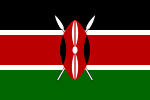| Demographics of Kenya | |
|---|---|
 Population pyramid of Kenya in 2020 | |
| Population | 51,044,355 (2022 est.) |
| Growth rate | 2.12% (2022 est.) |
| Birth rate | 26.39 births/1,000 population |
| Death rate | 5.01 deaths/1,000 population |
| Life expectancy | 69.69 years |
| • male | 67.98 years |
| • female | 71.43 years |
| Fertility rate | 3.29 children |
| Infant mortality rate | 27.86 deaths/1,000 live births |
| Net migration rate | -0.19 migrant(s)/1,000 population |
| Nationality | |
| Nationality | Kenyan |
| Part of a series on the |
| Culture of Kenya |
|---|
 |
| Cuisine |
The demography of Kenya is monitored by the Kenyan National Bureau of Statistics. Kenya is a multi-ethnic state in East Africa. Its total population was at 47,558,296 as of the 2019 census.[1]
A national census was conducted in 1999, although the results were never released. A new census was undertaken in 2009, but turned out to be controversial, as the questions about ethnic affiliation seemed inappropriate after the ethnic violence of the previous year.[2] Preliminary results of the census were published in 2010.[3]
Kenya's population was reported as 47.6 million during the 2019 census compared to 38.6 million inhabitants 2009, 30.7 million in 1999, 21.4 million in 1989, and 15.3 million in 1979.[4] This was an increase of a factor of 2.5 over 30 years, or an average growth rate of more than 3 percent per year. The population growth rate has been reported as reduced during the 2000s, and was estimated at 2.7 percent (as of 2010), resulting in an estimate of 46.5 million in 2016.[5] As of 2024 kenya has 770,255 refugees and asylum seekers [6]
- ^ "Kenya Population (2019)". Daily Nation. Retrieved 4 November 2019.
- ^ Kenya begins contentious census BBC News, 24 August 2009.
- ^ Kenya defends tribal census figures BBC News, 31 August 2010.
- ^ "Kenya: Provinces, Counties, Cities, Towns, Urban Centers – Population Statistics in Maps and Charts". Citypopulation.de. Retrieved 7 November 2017.
- ^ "CIA World Fact Book – Kenya". CIA – The World Fact Book. Retrieved 7 November 2017.
- ^ "Kenya refugees". 2024.